
G-Cloud 13
Services Definition Document
May 2022

2
Table of Contents
1. Tatonsy Consulting Services ......................................................... 3
1.1 Oracle Cloud HCM implementation and integration services ......................... 3
eJada Implementation framework .............................................................................................. 3
1.2 HCM Solution and vendor selection services ................................................ 8
1.3 HR Business analysis and business processes re-engineering services ....... 9
1.4 Oracle Cloud HCM readiness and advisory services ................................... 10
1.5 Oracle Cloud HCM training and learning services ....................................... 11
1.6 Oracle Cloud HCM quality management and testing services ..................... 13
1.7 Oracle Cloud HCM project management services ....................................... 17
1.8 Oracle Analytics Cloud implementation services ......................................... 19
eJada for Analytics Implementation framework ....................................................................... 19
1.9 Oracle Cloud Applications data migration services ...................................... 23
2. Pricing, ordering and invoicing ..................................................... 26
2.1 Pricing .......................................................................................................... 26
2.2 Ordering and Invoicing ................................................................................. 26
2.3 Discounts ..................................................................................................... 26
3. Termination .................................................................................. 27
3.1 Termination by Clients ................................................................................. 27
3.2 Termination by Tatonsy ............................................................................... 27
3.3 Service credits ............................................................................................. 27
4. Additional Information .................................................................. 28
4.1 Project kick-off and onboarding ................................................................... 28
4.2 Off-boarding ................................................................................................. 29
4.3 Technical requirements ............................................................................... 29
4.4 Service management ................................................................................... 29
4.5 Service constraints ...................................................................................... 29
Maintenance windows .............................................................................................................. 29
Permitted customisation ........................................................................................................... 29
4.6 Service levels............................................................................................... 29
4.7 Customer responsibility ............................................................................... 30
4.8 Technical requirements ............................................................................... 30
4.9 Information privacy and security .................................................................. 30
4.10 Backup and disaster recovery.................................................................... 30
4.11 Data migration and integration ................................................................... 30

3
1. Tatonsy Consulting Services
1.1 Oracle Cloud HCM implementation and integration services
Helping our clients through their HR Transformation journey by implementing Oracle HCM (Cloud or
hybrid), focusing on their key capabilities and end goals. We work with your people and ensure that
people, processes, technology and strategy are aligned to deliver outstanding user experience,
insightful analytics and minimal risks.
eJada Implementation framework
eJada is our robust and repeatable framework that we developed based on our 25 years of
experience in digital transformation projects enabled by Oracle HCM and utilising different project
management approaches (e.g. Waterfall, Agile), standards (e.g. PMI), generalist methodologies (e.g.
PRINCE2), specialist methodologies (Oracle Unified Method – OUM, SAP Activate) and Oracle Cloud
Project Management framework.
Key Characteristics:
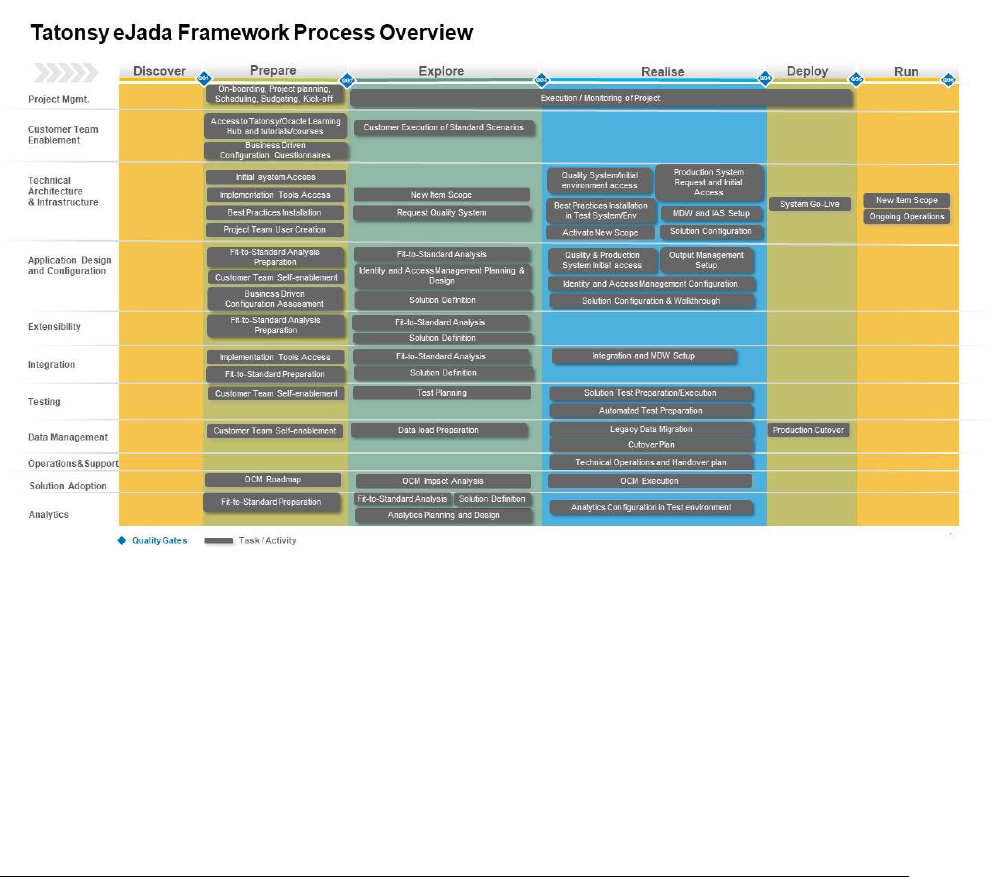
4
• Start with best practice: Use ready to run business process
• Validate solution: Validate to best practices with fit-gap workshops, capture delta
• Modular, Scalable and Agile: Structure the project to deliver the solution incrementally
• Cloud Ready: Leverage the flexibility and the speed of the cloud
• Adaptable: Requirements, solution and innovation driven
• Quality built-in: Identify risk early with total quality approach
Structure:
eJada consists of five (5) phases and eleven (11) workstreams.
Phases are stages of the project. At the end of each phase, a quality gate exists to verify the
completion of the deliverables. A workstream is a collection of related deliverables that show time
relationships within a project and among other streams. Streams can span phases and are not
necessarily dependent on phase starts and end.
Process Overview:
Prepare Phase
The purpose of this phase is to provide the initial planning and preparation for the project. In this
phase, the project is started, plans are finalised, project team is assigned, and work is under way to
start the project optimally.
Prepare Phase Activities:
• Define project goals, a high-level scope, and a project plan
• Identify and quantify business value objectives

5
• Best Practices Installation
• Establish project standards, organisation and governance
• Define roles and responsibilities for the project team
• Validate the project objectives
• Establish project management, tracking, and reporting mechanisms for value delivery
• Begin self-enablement
• Receive and access the cloud Development/Demo environment
• Kick off the project
Explore Phase
The purpose of this phase is to perform a fit-to-standard analysis to validate the solution functionality
included in the project scope and to confirm that the business requirements can be satisfied. Identified
gaps and configuration values are added to the backlog for use in the next phase.
Explore Phase Activities:
• Project Management Execution and Monitoring
• Customer Project Team Enablement
• Fit-to-Standard Analysis
• Solution Definition
• Plan and Design Identity & Access Management and Analytics
• Solution Extension Preparation
• Request for Quality System
• New scope Item Activation
• Data Load Preparation
• Phase Closure
In the Explore phase, industry and solution experts from Tatonsy Consulting lead a series of
structured show-and-tell and solution design workshops. The goal of these workshops is to review the
best practice functionalities of the Oracle solution, identify delta requirements or gaps and determine
the configuration of the Oracle cloud solution.
Realise Phase
The purpose of this phase is to incrementally build and test an integrated business and system
environment that is based on the business processes and process requirements identified in the
previous phase and captured in the backlog. During this phase, the project team loads customer data
into the system, plans adoption activities, and prepares cutover plans and plans for operationally
running the solution.
Realise Phase Activities:
• Establish the solution landscape
• Implement the solution in the quality environment using incremental build in time-boxed
iterations
• Conduct overall end-to-end testing of the solution
• Best Practices Installation in Test System/Tenant
• Integrated Identity Management Setup
• Integration Setup
• Output Management setup
• Initial Access to Quality System/Test tenant
• Request for production system and initial access
• Prepare for data migration
• Finalize end user training materials and documentation
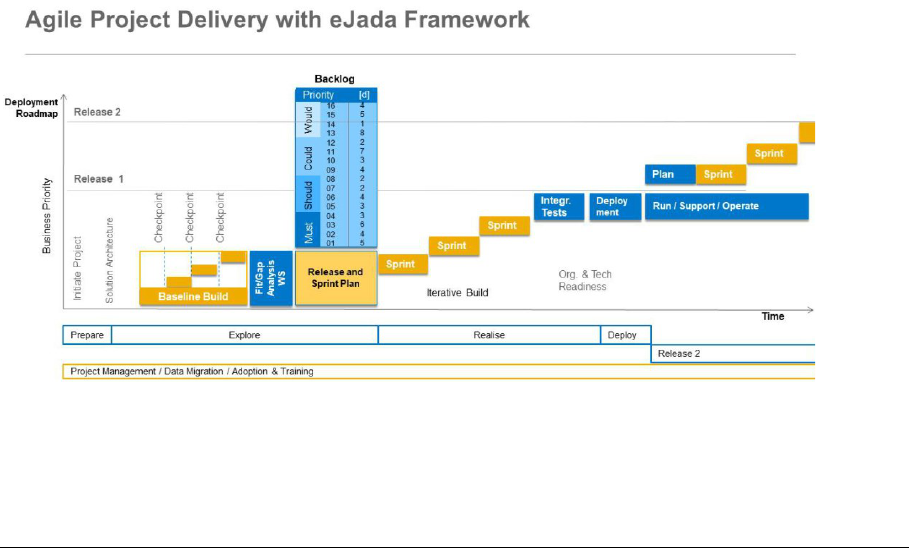
6
During Realise phase, the project team uses a series of iterations to incrementally configure, test,
confirm, and document the entire end-to-end solution and to load data. The project team actively
works with business representatives to ensure good fit of the built solution. The project team releases
results of multiple iterations to the business users to accelerate time to value and provide early
access to finalized functionality.
Deploy Phase
The purpose of this phase is to set up the production system, confirm customer organization
readiness, and to switch business operations to the new system.
Deploy Phase Activities:
• Finalise the solution and business processes for production go-live
• Production Cutover
• Resolve all crucial open issues
o Conduct system tests
o Proceed with cutover activities including data migration
Run Phase
The purpose of this phase is to further optimize and automate the operability of the solution.
Operability is the ability to maintain IT systems in a functioning and operating condition, guaranteeing
systems availability and required performance levels to support the execution of the enterprise’s
business operations.
Project Delivery:
eJada can be combined with Agile (e.g. Scrum, Kanban, SAFe, etc.), Waterfall or two-speed (mix of
Agile and Waterfall) delivery approaches.

7
Quality Management:
eJada adopts Test Driven Development (TDD), Behavioural Driven Development (BDD) and the V-
Model as the standards for implementation/development life cycle. The Project Quality Gate process
is a formal way of specifying and recording the transition between critical stages in the project
lifecycle. Each Project Quality Gate verifies that acceptance is met for the deliverables required and
actions to be completed for the associated critical stage.
This means that each deliverable is verified, validated and tested to identify problems as early as
possible.
• Verification (doing it the right way) checks a deliverable is correctly derived, internally
consistent, the output and the process conform to the standards, and is performed by
inspecting and reviewing.
• Validation (doing the right thing) checks output deliverable is in scope, satisfy the
requirements specified in previous stage, contributes to intedend benefits, without side-
effects, and is performed by inspecting, simulating, or prototyping.
• Testing (Right things working right) checks that a specification is properly implemented,
meets the business and performance requirements, and is performed by executing the
application and/or the custom code.
Assets and tools:
eJada is using several programme and project management assets, tools and established capabilities
for delivery including:
• Monitor and track delivery performance tools: Key reporting can vary depending on the
project / programme and delivery methodology but can typically include: Schedule
performance index (SPI); Delivery progress / earned value (EV); Burndown charts (for Agile
delivery); Milestone tracking; Risk / issue / dependency status and Quality metrics including
design defect and test defect metrics
• PRINCE2 compliant assets that can be adapted to context include: Project Initiation
Documents (PID); Programme Requirements logs; Programme / Plan templates in multiple
formats; Estimator and Cost models; Risk and Issue logs; Benefits realisation approaches
and templates; Value tracking; and many more.

8
1.2 HCM Solution and vendor selection services
Helping our clients through their HCM systems selection journey by understanding the client
capabilities, vision and goals, navigating the market place, understanding the sophistication of
different products and services and making the selection of the right solution and vendor beyond the
marketing and sales hype.
Procedures:
- Conduct the selection process to achieve the following objectives:
▪ Solution and vendor strategic alignment to the business vision
▪ Solution functional fit – How it can support the organisation’s required business
processes
▪ Solution non-functional and technical fit– How the product can integrate with other
business systems and infrastructure components, software suitability, including total cost
of ownership and software stability
- Choose solutions using both traditional waterfall and Agile software selection approaches
- Evaluate selected solution on meeting the latest technology trends and disruptive technology
objectives (personalisation, mobility, Bring Your Own Device - BYOD, flexibility, user
experience, collaboration and social engagement, diversity and inclusion, wellbeing, user
driven, customer centred, cloud based, etc.)
- Manage and deliver the following selection steps:
▪ Scoping and validation – understand the current business vision, strategy and IT context
▪ Develop selection criteria – Analyse and prioritise requirements aligned to the business
vision
▪ Market assessment – Identify a long list of vendors able to support the cost and change
management capability based on publicly available information (vendor website,
brochures), independent industry analysis (e.g. Gartner, Forrester reports), client
recommendations and my personal market knowledge and experience. Validate the list
with the business stakeholders.
▪ Software and vendor evaluations – Determine the short list and understand product and
vendor capabilities in relation to the requirements, through RFI / RFP, demonstrations,
and Proof of Concepts assessed against the selection criteria
▪ Detailed analysis and findings – evaluating products and vendors, and recommending the
top of the list
- Adhere to the key quality principles throughout the selection process:
▪ Objectivity – The evaluation is evidence based
▪ Consistency – Applying the same process and criteria to all solutions and vendors in the
same way at each stage in the process
▪ Rigour – Basing evaluation criteria on a formal set of agreed requirements
▪ Transparency – traceability through all steps in the process and ensuring transparency of
decision-making

9
1.3 HR Business analysis and business processes re-engineering services
Supporting our client's implementation or transition to any Cloud HCM by studying your strategy, pain
points and business processes defining your real requirements (functional and non-functional). We
ensure the delivery of your stakeholder expectations through requirements analysis, user experience
design and strategy alignment.
Procedures:
- Define business and project objectives
- Identify and manage stakeholders
- bridge the gap between business and IT, translating technical jargon into user friendly
information
- Address problem issues head-on in a proactive fashion
- Run and manage information gathering workshops, meetings, interviews, interactive design
sessions, presentations, and training sessions
- Apply the requirements pyramid concept to capture the business objectives and
requirements, (the "What"), and defining specifications and systems impact on business
processes (the "How")
- Harmonisation of practices and processes, and applying full HCM suite implementation
expertise, coupled with a focus on change management, adoption and long-term
sustainability
- Model business processes using context diagram, functional flow diagram, cross functional
flow diagram and flowcharts
- Apply statistical process controls (SPC) to assess and improve processes effectiveness and
consistency (e.g. cost, waste, hours taken, overall delivery lead time, percentage delivered
on time, quality, accuracy and employee satisfaction)
- Manage the traceability matrix
- Assist in product testing and UAT test cases
- Develop operational procedures and user guides by role
- Manage the changes to requirements and reflecting the change in all associated
documentation
- Assist in project management plans and schedules (if needed)
- Agile (Scrum/Kanban) Business Analysis
▪ Define roles and personas
▪ Document and manage journeys, epics and their mapping to the user stories
▪ Apply the required Agile techniques (e.g. purpose alignment model, Kano analysis,
story decomposition, story mapping and value stream mapping, etc.)

10
1.4 Oracle Cloud HCM readiness and advisory services
Helping our clients to effectively plan and accelerate implementation of Oracle HCM Cloud. We run
structured workshops with the stakeholders from HCM functional areas to understand customer
requirements and develop a comprehensive business case, solution roadmap and a complete view of
functional processes and key data/process connection points when migrating to Cloud.
Procedures:
- Conduct a high level assessment of the current application landscape
- Identify key business drivers and priorities for future and any business benefits that may have
been over looked
- Identify and examine of how Oracle HCM Applications will affect the customer’s existing IT
infrastructure
- Conduct a product demonstrations through “hands-on” Oracle HCM
- Identify high level reporting and business intelligence requirements
- Develop a high level roadmap for implementation and target operating model
- Engage with the clients to understand both the challenges that exist within their own
environment and also the capabilities that can be leveraged to lead to a successful
implementation
- Ensure the customer is ready to engage with the technical element of the implementation
team from day one
- Document and refine the supporting business case ensuring benefits identified can be
measured and delivered accordingly
- Ensure the business case alignment and compliance with the HMT Green Book (Government
Organisations)
- Create awareness within the business around the Oracle products providing alignment and
clarity in thinking through hands-on customer experience
- Promote client understanding around the fundamental principles of service delivery,
promoting process alignment to industry best practices, facilitating informed decision making
- Provide the Clients insight into how Cloud will transform their business operation on
implementation

11
1.5 Oracle Cloud HCM training and learning services
Providing end-user, train-the-trainer, Oracle University standard training, technical and organisation
change management training and learning on the configured-system and processes (instructor-led
training, live virtual classes and online recorded sessions)
Creating job-aids and context-sensitive help files (HTML/Videos).
We delivered numerous training to our clients and Oracle University. Our trainers are highly qualified
consultants with decades of experience in Oracle HCM implementation and transformation projects;
they understand booth business, organizational change management and technical aspects of the
training, in addition to content design and delivery methods.
With the continuous changes to the business, the organization and Oracle HCM functionalities and
features; our trainers are fully qualified and experienced to understand your business and assess the
required changes to the training media, format and contents, with detailed analysis of the impact on
the training objectives and trainees’ skill required.
Prepare and Explore
- Identify training needs
▪ Identify training key message and training strategy
▪ Understand the project vision, roadmap and business context
▪ Identify processes and develop Content-Outline on functionalities to be covered
▪ Identify training environments and classroom plan
▪ Establish Training Team
- Design Training Materials/Documents
▪ Design layout of the training media
▪ Design functional & technical contents
▪ Design query and report writing training
- Update Training & Support Materials Plan
Realise
- Develop Training & Support Materials/Documents
- Evaluate Training & Support Materials:
▪ Develop Training Schedule for each functional and technical area
▪ Test Training Materials for accuracy and completeness
▪ Test Training environment, data, reports and integration
▪ Train the trainers
Deploy
- Publish Training Documents and materials
- Deliver Training to the end users
- Add additional training based on needs and feedback

12
Run
- Liaise between functional areas and the Help desk to troubleshoot problems/answer
questions
- Track Training effectiveness by getting feedback from the end users
- Prioritise changes to the training delivery and material

13
1.6 Oracle Cloud HCM quality management and testing services
Helping our clients in their Oracle Cloud HCM implementation by testing the delivered system and
processes. Testing is a crucial component of ensuring that releases are functional and meet the
quality and performance demands of our clients. Testing is a frequent activity that takes place
throughout the implementation process.
Testing Cycles:
Our services include different cycles/types of testing; the following are examples of types of testing we
offer to our clients:
Functional Testing
Functional testing contains five different stages:
• Component test. Sometimes called unit test, this tests the individual units of an entire
solution. The test ensures that the component (or module) is built and behaves as detailed in
the specifications. Component testing is the lowest level of testing.
• Assembly test. Sometimes called string test, this tests the assembly and combined
operation of related components. It ensures that the interactions between the components
function correctly.
• Product test. Sometimes called system test, this tests that all functional and business
requirements have been met by the system. It can be broken down into two separate tests for
systems that involve multiple applications (for example, enterprise integration):
o Application product test. A test of the business requirements met by each
individual application.
o Integration product test. An end-to-end test of the business requirements across all
applications and platforms. Upon successful completion of the application product
test, integration product test can occur.
• User Acceptance Test (UAT). Ensures that the users and stakeholders are satisfied with
the solution. Only after this test is complete can the product be released.
Technical Testing
There are two types of technical tests that ensure the smooth transition of systems to production and
complete the testing life cycle.
• Performance test. This test is carried out to ensure that a release is capable of operating at
the load levels specified in the business performance requirements and any agreed-on
Service Level Agreements (SLAs).
• Operational Readiness Test (ORT). Tests the readiness of the production environment to
handle the new system. It is comprised of three components:
o Operations test. Verifies that the correct functionality, architecture, and procedures
are defined and implemented to allow production support teams to run, maintain, and

14
support the system in production in accordance with common practice or defined
SLAs, where applicable.
o Deployment test. Verifies that all system components are collated and can be
correctly deployed to the production environment in the time required.
o Deployment verification test. Verifies that the system is correctly installed and
configured in the production environment.
The set of test stages outlined above is not exhaustive, and further testing may be required to prove a
release. Particular projects may need additional test stages (e.g., technical architecture test).
Phase Containment
The goal of phase containment is to identify problems in the system during a phase before they are
passed to the next phase. This helps build quality into the system. Finding problems or errors in the
phase they occur in is important because problems become more expensive and difficult to fix later in
the project life cycle.
Testing Process:
Prepare Phase
- Client Team Self-Enablement
▪ The purpose of this deliverable is for the client to learn different elements of the Oracle
Cloud HCM using self-paced enablement materials. Cloud projects are intended to be
completed in a shorter time period which requires more focus on learning tools. It is
important that self-enablement begins prior to the project kickoff in order to maximize the
time for learning and create efficiencies in later deliverables.
Explore Phase
- Test planning
The purpose of this deliverable is to plan, design, and prepare for testing the configured
or built system. Key deliverables during this phase include an agreed test strategy and
test plan/test schedule. It is important to note the relevant prerequisites that should be in
place before end to end takes places.
It is necessary to consider and plan for the testing cycles required during testing activities
and understand what needs to be completed for testing. During this deliverable, existing
tests, quality management processes, and procedures which may occur can be leveraged
to support the project.
It is recommended that client engage our Test Manager to the project at the earliest
opportunity. The Test Manager is then able to work with the module process leads as well
as technical leads to build up knowledge of business processes before executing the
User Acceptance Testing.
▪ Create Test Strategy
The purpose of this task is to agree on the key elements of the test
strategy and document them in the test strategy document. Typically, there is one signed
and approved test strategy which will cover the entire project duration and is often owned
jointly by the client and Tatonsy Consulting. This step is very important as it defines how
testing will be performed and completed in the project. All project members and
stakeholders must agree and align to the agreed approach before testing starts.

15
The test strategy contains:
o Project Testing Objectives and Assumptions:
A statement of the objectives and the assumptions around the objectives
o High-level Test Plan(s):
High-level schedule of testing activities
o Test Scope:
Testing activities which are relevant to the project
o High Level Processes:
List of high level processes that need to be tested
o Test Cycle:
The different phases of testing within the test execution:
Unit Testing (if applicable)
Business Process (String) Testing
Integration Testing
Data Conversion Testing
User Acceptance Testing
o Testing Approach:
A detailed description of how different test types relate to each other (i.e. a successful
unit test is a prerequisite for doing a string test, or migration test results may lead into
a prerequisite for a user acceptance testing)
An understanding of how the test phases will be planned and executed
What the content of the test type is
Entry and exit into the test phases
Who will be involved?
o Testing Deliverables:
Test processes per phase, test environment, and test tools
o Test Automation (Recommended):
How will the scope be determined?
When will the test automation work start?
▪ Create and Schedule Test Plan
The purpose of this task is to create a test plan and optionally a detailed test schedule.
o Define the test scope, containing:
Test cases
Dependencies
Prerequisites
o Test scope agreement by the project team (client and Tatonsy Consulting), involved
business process experts, and stakeholders.
o Optional: Plan resources and timelines. A detailed schedule can either be created for
the entire project, or for each individual test phase. It contains:
Key prerequisite testing activities
Scope items (test cases) and unique test case IDs
Dependencies and milestones
Test execution start dates and duration
Resource allocation
Timeline showing the testing tasks and when they will occur
Test status tracking (if required)

16
How and when will the automation test scripts be used?
o Testing Tools:
The following tools are used to perform different tests (i.e. manual test management
tool, test automation tool, defect tracking tool)
o Defect Management:
Description of how defects will be documented (i.e. what information must be
documented, any standards that need to be followed)
Detail of the defect lifecycle and various statuses
Detail of priority and severity of defects
o Roles and Responsibilities:
Description of required test roles and responsibilities (i.e. Test Lead and
responsibilities of individual project team members related to testing)
Realise Phase
- Test Preparation
To prepare the test scenarios, test cases, and/or test scripts for test execution.
If test automation is in scope, test scripts need to be setup/scripted in the test automation
software.
▪ Set Up Users for the Test Automation Tool
▪ Define a Test Case
▪ Create Test Process (Test Case)
▪ Edit Action Data and Change Visibility of Test Process
- Test Execution
The purpose of this deliverable is to test the system. Test execution during the Realise phase
is a very important activity where the previous activities of planning and preparation come
together to test the system. This is where planned and prepared tests are executed, status is
recorded, and defects are raised, fixed, and tested.
▪ Create Test Plan
▪ Change Test Data Using Data Variant
▪ Execute the Test Plan
▪ Correct and Re-run Test Plan
▪ Test Execution Analysis and Reporting
Run Phase
- Release Cycles for Oracle Cloud HCM
To prepare for the quarterly release and regression test the new functionalities.
▪ Prepare for Post Upgrade Testing
▪ Provide Consent for Post Upgrade Testing
▪ Maintain Master Data and Transaction Data
▪ Maintain Test User Credentials
▪ View Post Upgrade Test Result
▪ Execute Regression Testing
▪ Test Execution Analysis and Reporting

17
1.7 Oracle Cloud HCM project management services
Helping our clients through their HR Transformation journey by managing the implementation of
Oracle HCM (Cloud or hybrid), focusing on their key capabilities and end goals. We work with your
people and ensure that people, processes, technology and strategy are aligned to deliver outstanding
user experience, insightful analytics and minimal risks
eJada is our robust and repeatable framework that we developed based on our 25 years of
experience in digital transformation projects enabled by Oracle HCM and utilising different project
management approaches (e.g. Waterfall, Agile), standards (e.g. PMI), generalist methodologies (e.g.
PRINCE2), specialist methodologies (Oracle Unified Method – OUM, SAP Activate) and Oracle Cloud
Project Management framework.
eJada consists of five (5) phases and eleven (11) workstreams.
Phases are stages of the project. At the end of each phase, a quality gate exists to verify the
completion of the deliverables. A workstream is a collection of related deliverables that show time
relationships within a project and among other streams. Streams can span phases and are not
necessarily dependent on phase starts and end.
Project Management Workstream
Prepare Phase
- Project Initiation and Governance
▪ Create Project Charter and Scope Statement
▪ Establish Project Governance
▪ Define Project Communications and Reporting
- Project Plans, Schedule and Budget
▪ Create Project Schedule and Budget
▪ Align Project Schedules
- Project Standards, Infrastructure, and Solution
▪ Define Project Standards
▪ Set Up Project Team Logistics and Infrastructure
▪ Verify Project Team Certification and Experience
▪ Create a Document Repository for the Implementation Project Team
- Project Kick-Off and On-Boarding
- Phase Closure and Sign-Off Phase Deliverables
▪ Conduct Project Quality Gate
▪ Obtain Customer Sign-Off for Phase Completion
Explore Phase
- Execution/Monitoring of Project
▪ Direct and Manage Project Execution
o Perform project tasks to reach project objectives
o Expend effort and funds to accomplish project objectives
o Staff, train, and manage the project team members assigned to the project
o Obtain, manage, and utilize resources
o Implement and execute the planned methods and standards

18
o Create, control, verify, and validate project deliverables
o Manage the scope of the approved work
o Manage risks and implement risk response activities
o Manage issues to closure
o Adapt approved changes into the scope, plans, and project environment
o Establish and manage internal and external communications
o Collect project data and report on progress and performance
▪ Update Project Management Documents
▪ Manage Project Issues, Risks, and Changes
o Control Issues
o Raise the issue and properly classify it and assign the priority and the responsible
person for resolution of the issue.
o Follow up on issues on a regular basis in addition to the standard issue management
process defined for the project (part of the management plans). Critical issues will be
reviewed as an input for each Quality Gate review meeting.
o Review and update open issues on regular basis and communicate to the appropriate
stakeholder groups as part of the regular project reporting and communication.
o A central issue tracking system (e.g. a support or an incident ticket system) allows
stakeholders to manage and maintain lists of issues that require action and resolution
to ensure the success of the project.
▪ Communicate Project Status and Progress
o Produce project performance reports
o Communicate the progress of the key activities, completion of the deliverables and
status against the schedule and budget.
o Produce team member status updates every week and share them with the team
lead.
o Produce team status reports on regular cadence, typically weekly. The team status
reports are prepared by the team leads and are delivered to the project manager as
an input for the project status report. Review the team status report in regular team
review with Project Manager or provided in a predefined format.
o Produce weekly Project status report based on the input from individual teams and
additional information like issues list, risk list, etc.
o Prepare executive status report on monthly or quarterly cadence and provide it to the
project executive steering group.
o Review and update the project communication matrix throughout the project.
- Phase Closure and Sign-Off Phase Deliverables
▪ Conduct Project Quality Gate
▪ Obtain Customer Sign-Off for Phase Completion
Realise Phase
- Execution/Monitoring of Project
- Phase Closure and Sign-Off Phase Deliverables
Deploy Phase
- Execution/Monitoring of Project
- Phase Closure and Sign-Off Phase Deliverables
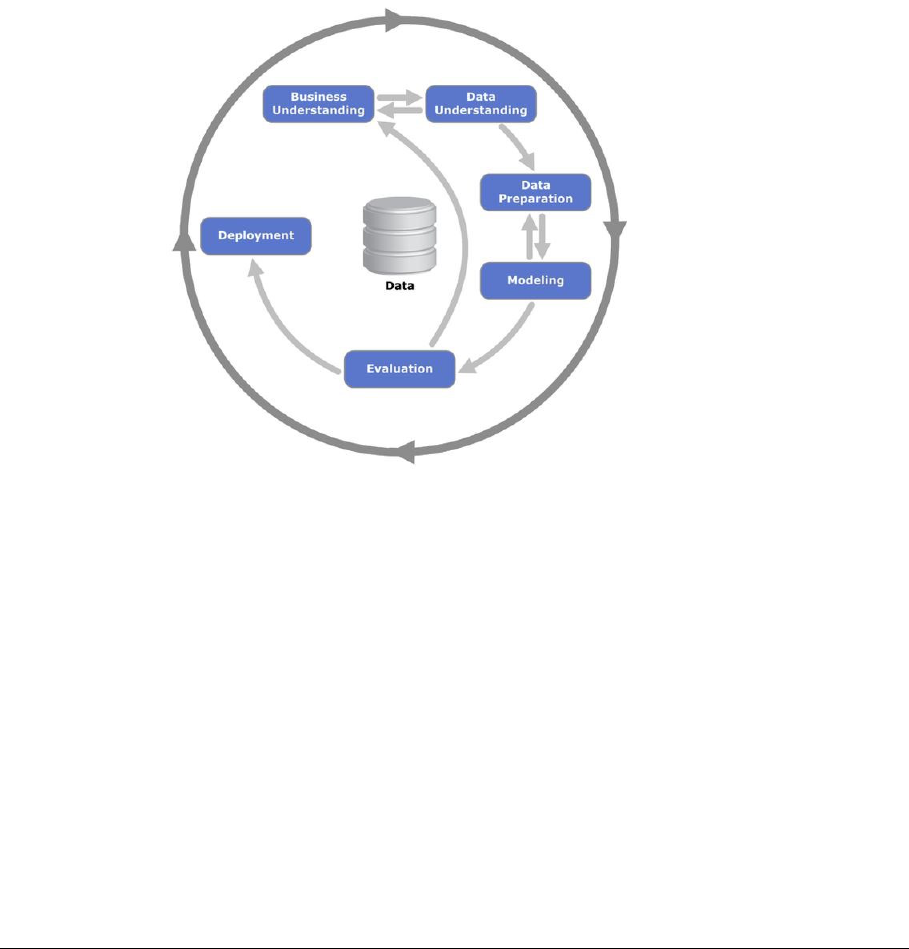
19
1.8 Oracle Analytics Cloud implementation services
Helping our clients through their HR Transformation journey by implementing Oracle Analytics and
Business Intelligence, focusing on their key capabilities and end goals. We work with your people and
ensure that people, processes, technology and strategy are aligned to deliver outstanding user
experience, insightful analytics and minimal risks.
eJada for Analytics Implementation framework
eJada is our robust and repeatable framework that we developed based on our 12 years of
experience in digital transformation projects enabled by Oracle Analytics and utilising different project
management approaches (e.g. Waterfall, Agile), standards (e.g. PMI), generalist methodologies (e.g.
PRINCE2), specialist methodologies (Oracle Unified Method – OUM, SAP Activate) and Oracle Cloud
Project Management framework.
The Framework is compatible with the Cross-industry Standard Process for Data Mining (CRISP-DM)
Structure:
eJada for Analytics consists of five (6) phases and ten (10) workstreams.
Phases are stages of the project. At the end of each phase, a quality gate exists to verify the
completion of the deliverables. A workstream is a collection of related deliverables that show time
relationships within a project and among other streams. Streams can span phases and are not
necessarily dependent on phase starts and end.

20
Process Overview:
Discover Phase
In the Discover phase, customers become familiar with the benefits of Oracle Analytics Cloud, and the
benefits it can bring to customers’ business.
The phase is structured into two parts:
• In a first step many customers want to (re)define their analytics strategy and learn about
Oracle Analytics Cloud business intelligence and augmented analytics capabilities.
The Analytics Strategy Workshop works out potential customer-specific road map options.
• In a second step a Cloud trial system could be provisioned to support the impact evaluation.
Prepare Phase
Once the business case has been approved, the project is initiated in the Prepare phase.
The formal setup of the project needs to be aligned with the customer project manager. The Prepare
Phase is also the point in time, where the Project team needs to be set up and enabled.
This phase ends with a first Quality Gate to ensure proper project preparation.
Explore Phase
Once the Prepare phase has been finalized considering a detailed planning for the functional and
technical work streams, the Explore phase will be kicked off.
In the Solution Adoption work stream, the training strategy is developed for the end users.

21
In the Application Design and Configuration work stream, the GAP Validation takes place and the
data models and stories are designed which will be configured in the Realise Phase. User Access and
Security Design is done in this phase, too.
In the Data Management work stream, the data load from the data sources or additional data
modelling in the source systems in case of live connections are prepared.
In the Integration work stream, plan and design the data connections of the data sources that shall be
connected to Oracle Analytics Cloud.
In the Analytics work stream, now the analytics design needs to be done with a detailed road map and
project plan, based on the findings from the Analytics Strategy Workshop.
In Technical Architecture and Infrastructure the test landscape is connected with live-data and data
load connections.
Realise Phase
Once Quality Gate 2 (i.e. Q2) – Explore-to-Realize has been passed successfully, the functional and
technical implementation takes place in the Realize phase.
In the Solution Adoption work stream, learning focusses on product enhancements in Oracle Analytics
Cloud.
In the Application Design & Configuration work stream the configuration of general settings takes
place. In addition, the data models and stories from the analytics design activity are configured in
Oracle Analytics Cloud. Security Implementation also starts in the realise phase. One very important
topic is the Integration Validation which is also part of this work stream.
In the Extensibility work stream you observe and make use of the product enhancements that are
implemented frequently in Oracle Analytics Cloud.
In the Data Management work stream, the data load and verification runs ensure business data can
be transferred and modelled correctly within an acceptable time limit and to a certain quality. At the
end of the Realise phase, the preparation for cutover starts, which for instance includes the setup of
the new productive environment.
In the Analytics work stream you start with the Analytics Configuration: You can work with existing
models, upload new content, or create new models from existing content.
Data connections and data integrity are thoroughly tested in the Testing work stream.
The technical infrastructure is set up in the Technical Architecture and Infrastructure work stream,
according to the technical design document.
In the Operations & Support work stream, the technical operations are checked and a handover plan
is documented.
Deploy Phase
Once quality gate Q3 – Realise-to-Deploy has been passed successfully, the final preparation for Go-
Live starts in the Deploy Phase.
In the Application Design & Configuration work stream, the integration validation activities will come to
an end.
Testing (in particular user acceptance testing) is taken care of in the Testing work stream.
The Integration Implementation on the productive landscape is done in the workstream Integration.

22
In Data Management, the cut-over preparations are finalised.
In the Technical Architecture and Infrastructure work stream, all connections to the production
environment are set up.
Run Phase
The transition project has ended with the Deploy phase. In the Run phase the aim is to further support
the solution adoption, for example with providing continuous learning, and collaboration on the Oracle
Analytics Cloud Community. The quarterly release cycles have to be prepared and new functionality
needs to be tested and adopted.
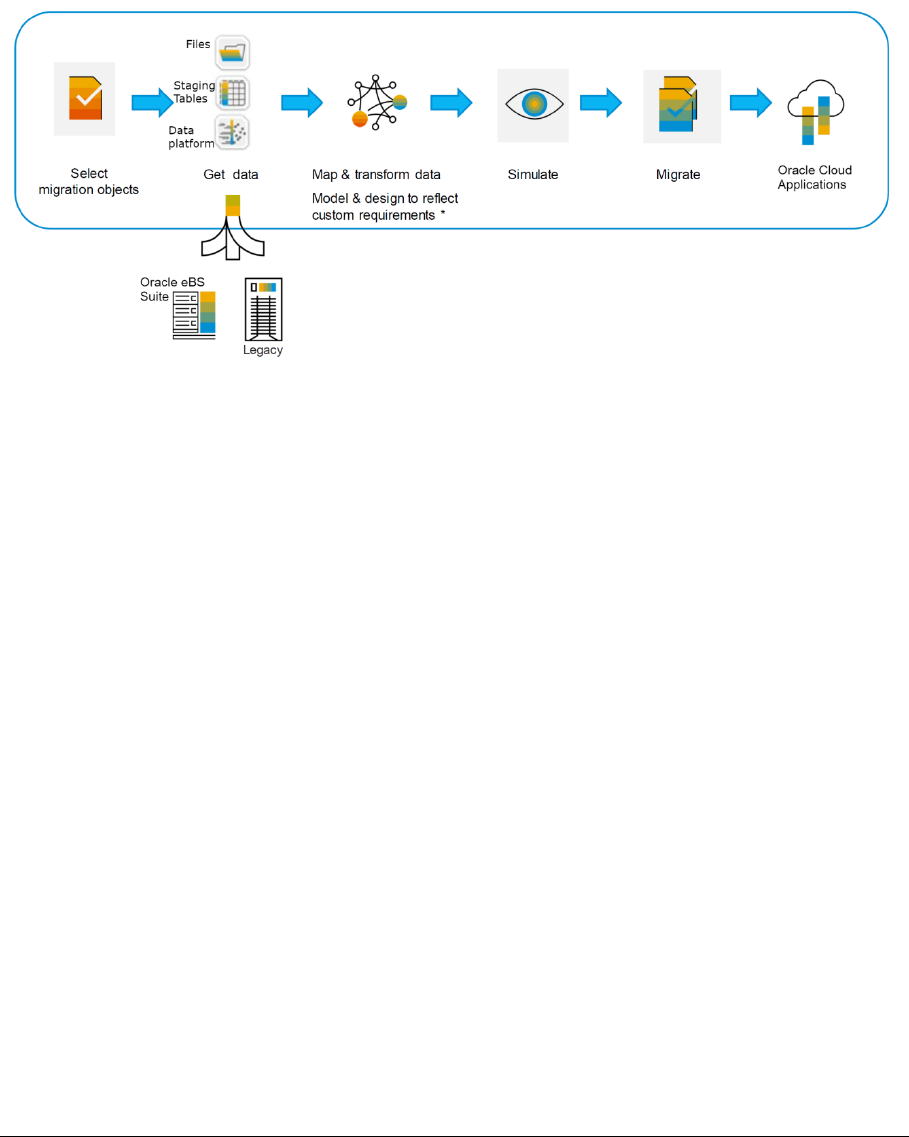
23
1.9 Oracle Cloud Applications data migration services
Helping our clients through their Oracle Cloud Applications implementation focusing on their data
migration activities. We work with your people and ensure that all data owners and sources are
identified, categorised and prioritised. We design a technical approach to extract, manipulate and
populate the source data into the target media (e.g. database, file or data platform/in memory),
identify and set up conversion tools utilising our ready-made and custom-built technical scripts to
ensure all data required by Oracle Cloud Applications is loaded and accurate.
Data Migration Approach:
- Transfer using files:
▪ Download template file for relevant migration object
▪ Populate file with relevant data from the legacy system/Oracle eBS
▪ Use Oracle Cloud File or Spreadsheet load tools to load the ready-to-load data into
Oracle Cloud Applications
▪ This approach is used if the data requires minimal cleansing, mapping or transformation
- Transfer using staging tables:
▪ Create the required staging tables (based on Oracle APIs or Spreadsheet Loader
templates)
▪ Populate the staging tables with relevant data
▪ Use the staging tables to cleanse, map and transform the data into Oracle Cloud
Applications templates
▪ This approach is used for complex types of data that requires effort for cleansing,
mapping and transformation
- Transfer using data platforms:
▪ Data platforms (e.g. Incorta, Snowflake, etc.) do not require creating staging tables
however; data (source databases and files) is identified and the data platforms is capable
of connecting to multiple sources and storing all data in columnar format in memory
▪ Using data loaded into the platform, create mapping, cleansing and transformation scripts
▪ Some platforms include Artificial Intelligence (AI) tools to curate and transform the data
(e.g. Tamr)
▪ This approach is used with very large and complex data that requires discovery,
investigation and curation
▪ This approach is perfect if the velocity and volume of data are considerably large
▪ This approach will incur extra costs for the data platforms licensing and usage
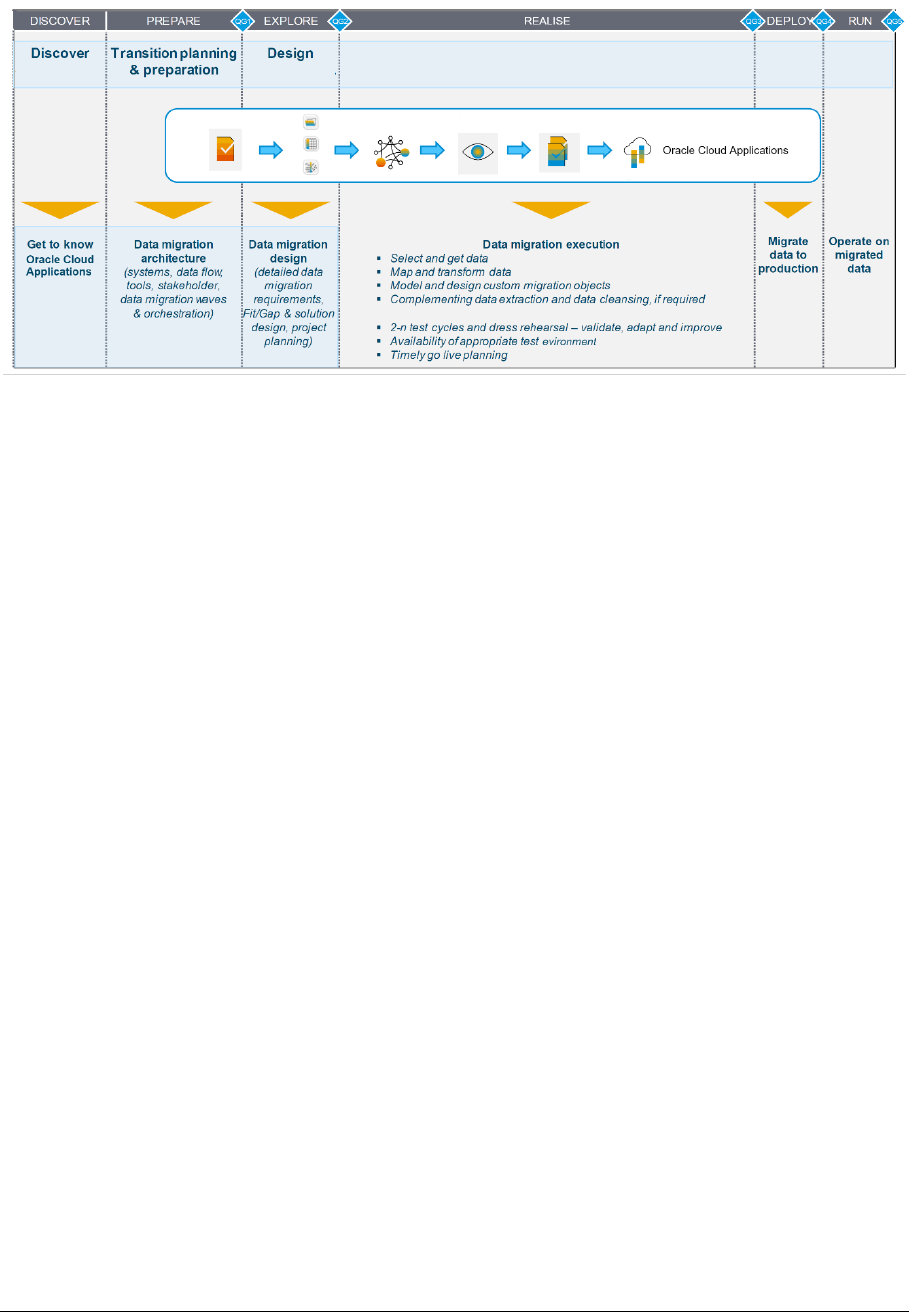
24
Data Migration Process:
Discover Phase
- Client Team Self-Enablement
▪ The purpose of this deliverable is for the client to learn different elements of the Oracle
Cloud Application and the data migration framework using self-paced enablement
materials. Cloud projects are intended to be completed in a shorter time period which
requires more focus on learning tools. It is important that self-enablement begins prior to
the project kickoff in order to maximize the time for learning and create efficiencies in later
deliverables.
Prepare Phase
- Identify sources of data
- Identify data owners
- Identify integrity constraints
- Identify co-existence and interface requirements
▪ Identify the issues related to co-existence of data in multiple sources (e.g. which source
takes precedence, when to sync up, and which data is updated, when, and by whom).
- Identify and select conversion and cleansing tools
- Documenting high level data migration strategy
Explore Phase
- The purpose of this deliverable is to begin the process of data migration. Data migration is the
process of taking existing data from a legacy system and preparing it for use in new Oracle
Cloud system. This process can be time intensive and should begin as soon as required
objects are identified in the new system.
The overall process involves the following:
▪ Determining the required objects
▪ Creating plans to extract data or create data
▪ Design data conversion process flow and procedures

25
▪ Configure conversion and cleansing tools
▪ Design extraction programs
▪ Design conversion and cleansing programs
▪ Design loading programs
Realise Phase
- Populate data into the Migration Templates
- Validate data and perform value mapping
- Simulate data migration
▪ Execute a simulation of the data migration and resolve all errors. At this point run the data
conversion without committing it to the actual test environment database tables. The
process can identify missing configuration or prerequisites related to the data.
- Execute data migration
- Conduct final data quality assessment and data reconciliation
- Develop the cutover plan
▪ Determine and document the strategy, scope and timelines for moving from the as-is
solution to the to-be solution and the support period immediately following go-live.
This includes a workshop to document activities such as the following list:
▪ Setting up and initialising the production system
▪ Setting up and verifying interface connections
▪ Migration or creation of master data via manual, data migration tool, and/or interfaced
system
▪ Migration of order objects (i.e. purchase orders, sales orders)
▪ Manually migration of data not transferred automatically in the new system.
▪ User creation
▪ Notification of impacted 3rd parties
▪ Go/no go decision points
▪ Closing the legacy systems
▪ Completing all required documentation for regulatory purposes
Deploy Phase
- Execute the production cutover plan
- Ready the business and system for production environment use use. The cutover plan
contains both business process tasks as well as system tasks. It is executed in the days prior
to the go-live date.

26
2. Pricing, ordering and invoicing
2.1 Pricing
Our services listed may be procured through a number of ways.
• Time & Materials – standard commercial arrangement based on the SFIA rate card for the
Services listed on the G Cloud 13 which will involve agreement to provide services and to
invoice monthly based on the work done.
• Fixed Price – we will agree with the client a fixed price for the services based on an estimate
of the work to be carried out, this will be invoiced by instalments based on deliverable
milestones (e.g. 40% down payment on signing the contract, 30% on passing the user
acceptance testing and 30% on completion).
• Fixed Capacity – in this instance the service will be defined up to an agreed fixed number of
resources (Core team) for a specific duration and not on the service / project outcome.
Monthly invoices or paid on pre-agreed intervals
• Transaction Based – the services will be charged based on the number of transactions done
within an agreed period of time (e.g. number of training sessions/trainees in a month).
• Outcome Based Pricing – the services are procured based on the desired outcome
expected due to the presence of the service/project deliverable(s). The SFIA rate card
includes rates for onsite resources.
2.2 Ordering and Invoicing
Orders through the G-Cloud framework would involve discussion of requirements, agreement and
completion of a Call Off contract, and submission of a Purchase Order. We would then set up a
mutually acceptable start date and commence work.
Invoicing would be based on whatever is most appropriate for the type of service being delivered,
from the submission of monthly timesheets and any expenses, or staged payments for the
consultancy tasks, through to milestone payments based on acceptance of deliverables for system
implementations. Payment terms are 30 days.
2.3 Discounts
We offer discounted rates to the Education sector and volume discounts to the larger engagements.
Please refer to the pricing document.

27
3. Termination
3.1 Termination by Clients
For all services offered on a fixed price basis these will be delivered in phases and paid by payment
milestones. Where work is terminated, Tatonsy will charge for the current phase and associated
milestone in progress.
For all services delivered on a time and material basis all services once commissioned can be
cancelled by giving a month’s notice in writing. Where work is cancelled, Tatonsy will charge four
weeks’ work and the allocated resources will be available to the client during this period for any task
that is appropriate to the individual’s skillset.
In case of any discrepancies, the agreed terms and conditions will prevail.
3.2 Termination by Tatonsy
Fixed price work can only be terminated by Tatonsy for the subsequent phase. Time and Material
work can be cancelled by giving a month’s notice.
In case of any discrepancies, the agreed terms and conditions will prevail.
3.3 Service credits
Any diminution of service away from the agreed Service Levels will be the subject of recompense in
accordance with the G-Cloud framework terms and conditions.

28
4. Additional Information
4.1 Project kick-off and onboarding
Project on-boarding is detailed in Tatonsy’s eJada framework in the discovery and prepare phases.
We are expecting the client to ensure key stakeholders and documentation are available from day
one of the engagement, and to grant Tatonsy team access to security badges/building access, the IT
network, Oracle HCM environment and any necessary laptops or equipments in addition to the client
repository/documentation including business and IT strategies and current state
architecture/landscape.
The purpose of this deliverable is to kick-off the project and ensure that all needed information is
shared with the project team resources, key stakeholders, and anybody involved in the project. The
goal of the kickoff meeting is to ensure that everybody involved in the project understands the goals
and objectives of the project, as well as the schedule that the project team will follow, which is one of
the key ingredients for a successful project execution.
On-board Project Team
The purpose of this activity is to prepare the onboarding package for external consultants and new
project team members from Tatonsy and partner companies coming to the project. The onboarding
package contains the essential information that each new team member needs to understand, which
is the purpose of the project, goals, operating procedures, and other key information.
Procedure:
- Ensure the onboarding package contains all the necessary information to properly onboard
the team members. The onboarding package typically contains the following information:
▪ Project objectives, scope, and goals including Oracle HCM modules being
implemented
▪ Project schedule including milestones
▪ Project governance including key project stakeholders
▪ Organisational chart for the project- showing both internal and external resources
▪ Outline of regular project meetings
▪ Travel policies, dress code, project location, and other project guidelines as needed.
Conduct Kickoff Workshop
The purpose of this task is to schedule, prepare, and conduct the project kickoff meeting.
Procedure:
- Finalise the attendance list for the kickoff meeting. Participants typically include: project team,
key stakeholders, project sponsor and company executives.
- Schedule the kickoff meeting. Some resources may attend the kickoff meeting remotely; in
such cases it is important to ensure good audio and video infrastructure so the remote
participants can take full part in the kickoff meeting session.

29
- Use the eJada Project Kick-off Template accelerator as a template to prepare kickoff meeting
materials specific to your project.
- Conduct the Project Team Kickoff Meeting. The kickoff meeting should include discussion of
project objectives, organisational structure, roles and responsibilities, project governance,
schedule, scope, communication standards, change request process, and decision making
process. The project manager should also utilise the meeting to ensure a mutual
understanding of the Project Plan. Furthermore, the project manager can use this meeting to
communicate methods that will be used to manage and control the project.
4.2 Off-boarding
All access granted to Tatonsy consultants or their partners should be revoked. All documentation,
client papers, laptops, equipments, security badges/building access and project deliverables should
be handed over to the client.
As agreed in the call off contract, we usually conduct a hand-over procedure with details of any
training required. This differs based on the project deliverables and agreed contract.
4.3 Technical requirements
Prior to any commercial agreements being made, any technical requirements would be discussed in
detail and form part of the Call Off contract.
4.4 Service management
Oracle Products are accredited to ISO9001 quality standards and delivered in line with ITIL 4
concepts and according to eJada project management framework. We are accustomed to working in
close collaboration with clients, often onsite, against agreed work and deliverable schedules.
4.5 Service constraints
Maintenance windows
Maintenance windows will be pre-agreed in line with the scope of the services purchased. The Oracle
maintenance window is approximately every quarter.
Permitted customisation
Tatonsy G-Cloud listings are costed with the Out of the Box functionality in mind. Clients may request
as much customisation as they feel is required but this will be subject to consultancy charges in line
with the SFIA rate card.
4.6 Service levels
Tatonsy services are offered via the Cloud Store and comply with the G-Cloud framework terms and
conditions. These G-Cloud terms and conditions are accompanied by Tatonsy’s own Terms and
Conditions, which are available on the Cloud Store.

30
Service levels will be defined in the PID and agreed at service on-boarding and will cover the
following aspects of consultancy service delivery:
• Time, as defined in the Project Plan. For example, a consultancy project to define the
requirements for the procurement of a new system may be constrained by the target date for
publishing an OJEU notice to the market.
• Cost, as defined in the Initial Business Case. For example, the client may wish to impose limit
of liability on the work, or agree a fixed price.
• Quality, as defined in the Quality Plan. For example, the work is to be carried out to a specific
level of detail e.g. technical design, level of detail surrounding functional and non-functional
requirements specifications.
4.7 Customer responsibility
For any given call off requirement, the dependencies on the customer associated with the work
(which would differ in each case) would be discussed and agreed before commencement, and form
part of the Call Off contract.
Our consultants and partners welfare while in the client’s office is our first priority and we value and
expect the client’s adherence to their health and safety practices.
4.8 Technical requirements
Prior to any commercial agreements being made, any technical requirements would be discussed in
detail and form part of the Call Off contract.
4.9 Information privacy and security
Tatonsy are committed to the principles of ISO27001 and strive to be a force for best practice data
management and security. Oracle Cloud data centres that we use for our Cloud services are
ISO27001 certified or equivalent. All Oracle Products are also certified to ISO27001.
4.10 Backup and disaster recovery
Oracle Cloud HCM clients and setup data are stored on Oracle Cloud data centres. Oracle practice
and SLA offer servers redundancy and regular data backup to avoid any outage, loss or damage.
In general, client’s data backup and disaster recovery procedures and invocation remain the
responsibility of the client. Tatonsy are however in the position to offer consultancy in this area.
4.11 Data migration and integration
Unless specifically stated as in scope within the relevant Service Definition section, Data Migration
and Integration will be scoped and costed on a case by case basis and in line with the SFIA rate
table.
